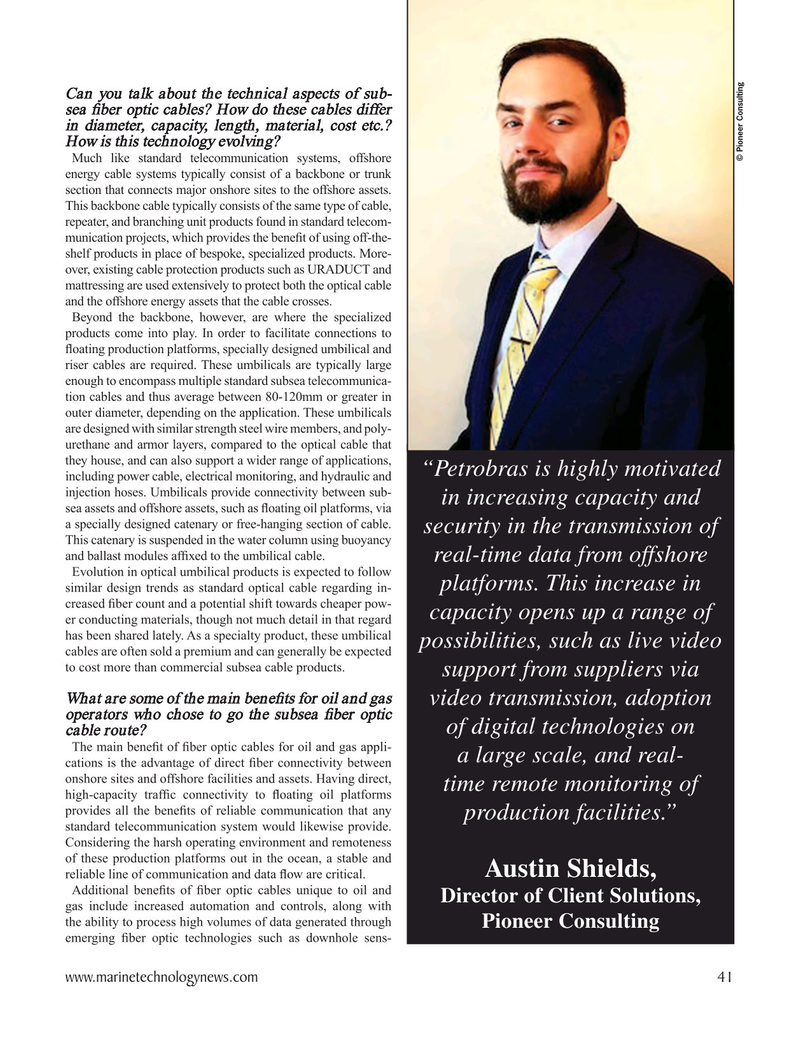
Page 41: of Marine Technology Magazine (May 2023)
Read this page in Pdf, Flash or Html5 edition of May 2023 Marine Technology Magazine
Can you talk about the technical aspects of sub- sea ? ber optic cables? How do these cables differ in diameter, capacity, length, material, cost etc.?
How is this technology evolving?
© Pioneer Consulting
Much like standard telecommunication systems, offshore energy cable systems typically consist of a backbone or trunk section that connects major onshore sites to the offshore assets.
This backbone cable typically consists of the same type of cable, repeater, and branching unit products found in standard telecom- munication projects, which provides the bene? t of using off-the- shelf products in place of bespoke, specialized products. More- over, existing cable protection products such as URADUCT and mattressing are used extensively to protect both the optical cable and the offshore energy assets that the cable crosses.
Beyond the backbone, however, are where the specialized products come into play. In order to facilitate connections to ? oating production platforms, specially designed umbilical and riser cables are required. These umbilicals are typically large enough to encompass multiple standard subsea telecommunica- tion cables and thus average between 80-120mm or greater in outer diameter, depending on the application. These umbilicals are designed with similar strength steel wire members, and poly- urethane and armor layers, compared to the optical cable that they house, and can also support a wider range of applications, “Petrobras is highly motivated including power cable, electrical monitoring, and hydraulic and injection hoses. Umbilicals provide connectivity between sub- in increasing capacity and sea assets and offshore assets, such as ? oating oil platforms, via a specially designed catenary or free-hanging section of cable. security in the transmission of
This catenary is suspended in the water column using buoyancy and ballast modules af? xed to the umbilical cable. real-time data from offshore
Evolution in optical umbilical products is expected to follow platforms. This increase in similar design trends as standard optical cable regarding in- creased ? ber count and a potential shift towards cheaper pow- capacity opens up a range of er conducting materials, though not much detail in that regard has been shared lately. As a specialty product, these umbilical possibilities, such as live video cables are often sold a premium and can generally be expected to cost more than commercial subsea cable products.
support from suppliers via
What are some of the main bene? ts for oil and gas video transmission, adoption operators who chose to go the subsea ? ber optic of digital technologies on cable route?
The main bene? t of ? ber optic cables for oil and gas appli- a large scale, and real- cations is the advantage of direct ? ber connectivity between onshore sites and offshore facilities and assets. Having direct, time remote monitoring of high-capacity traf? c connectivity to ? oating oil platforms provides all the bene? ts of reliable communication that any production facilities.” standard telecommunication system would likewise provide.
Considering the harsh operating environment and remoteness of these production platforms out in the ocean, a stable and
Austin Shields, reliable line of communication and data ? ow are critical.
Additional bene? ts of ? ber optic cables unique to oil and
Director of Client Solutions, gas include increased automation and controls, along with the ability to process high volumes of data generated through
Pioneer Consulting emerging ? ber optic technologies such as downhole sens- www.marinetechnologynews.com 41
MTR #4 (34-47).indd 41 6/1/2023 9:20:45 AM

 40
40

 42
42
